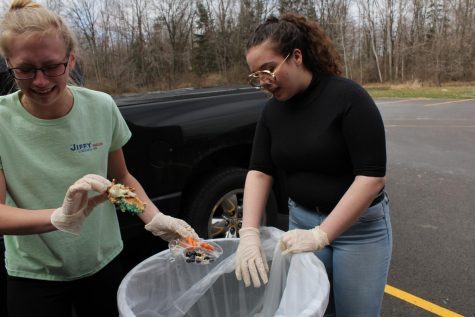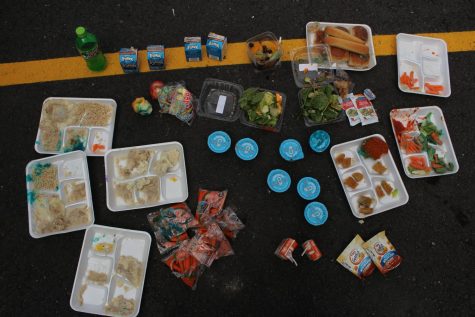Wasted.
The impacts of food waste in America
May 24, 2018
Say you go out to eat and get a massive, half-pound burger with bacon, lettuce and tomato, and a heaping side of fries. You do your best, but there is no way you can finish it. So, you just throw the rest away. Most of what was left was just fries, anyway, and no one likes reheated fries.
The catch is this: You are not the only one who disregards unwanted food. According to a 2014 study by the Environmental Protection Agency (EPA), America throws away over 38 million tons of food per year. That is the weight of over 15 million 2018 Chevrolet Silverado 1500s.
The main cause for this waste, senior Cami Ford believes, is the oversized portions given to customers in restaurants and bought in stores.
“They give you so much food in America,” Ford said. “There’s no way you’re going to eat everything. You go out to dinner and get a meal that’s like this big, you’re not gonna eat all of it. If it’s half your body weight, you’re not gonna eat that much food. You’re forced to take it home, and a lot of people won’t eat their leftovers if you don’t take them home from a restaurant.”
Moreover, food is the most common item in American landfills according to the EPA, and our own school lunchroom is a contributor.
After A Lunch on April 18, Uncaged staffers took the initiative to sort through all of the trash bins to see just how much food is wasted every day.
Among the waste were two full apples, seven barely touched and/or untouched bags of baby carrots, seven unopened containers of applesauce and four untouched cartons of chocolate milk, just to name a few items.
Freshman Isaac Lance thinks that this waste may be due to dislike of the foods offered.
“The food isn’t very good, so they might not eat all of it,” Lance said. “They might eat some of it, and later decide that they don’t want to finish it.”
Lunch trays from England, Germany, France with the most beautiful array of food litter feed on Instagram and Facebook–we have all seen the photos.
“In reference to all of the other countries, the quality for [school food] is probably worse,” Lance said. “I have seen some articles that talk about the different qualities of foods in different countries, so from that, I would say that it’s probably worse.”

Cringing at a soggy, partially-eaten piece of chicken from a chicken sandwich, senior Kali Roskowski moves the tray of blueberries and carrots and the chicken patty to the pile of uneaten food while senior Zabrina Yannella grimaces at the milk and mashed potato mix at the bottom of the trash bag.
Ford agrees, and she often brings a lunch to school because of the quality of the school foods.
“They make you take like a fruit or vegetable and usually their vegetables are pretty disgusting. If I bring my lunch, I feel like I get the freedom to pick things I actually want to eat, or that sound good, and with hot lunch, it’s usually not that great.”
Each student is required to take three out of the five meal components at lunchtime: grain, meat, fruit, vegetables and milk, according to Food Service Director, Stephanie White, and at least one of the components taken has to be at least a half cup of fruits and/or vegetables.
“We can only help enforce what parents are teaching, but [the FDA is] trying to make it our duty to do this,” White said. “Me, I look at the starving children and whatnot, and you’ll tell a high school student ‘you have to take this.’ They take it, and they throw it in the garbage right when they get past the register. It’s frustrating because it’s money wasted, and once a child touches it, we can’t give it to another student. I don’t agree with it, but it’s out of our hands.”
Though the force to take unwanted food can be irritating for students, there is a solution. If students are unsatisfied with the types of food provided, they can go to the Stockbridge website (panthernet.net) and complete a lunchroom survey, which includes a suggestion section for provided foods.
“Honest opinions is what we want,” White said. “We have guidelines that we have to go by. I may not agree with them all, but I have to go by them. But still, input from students on what they want and what their favorite meals are and things like that is helpful.”
The road to destructiveness
In this photo lay all of the food waste Uncaged found from A lunch on April 18.
 PHOTO KALI ROSKOWSKI
PHOTO KALI ROSKOWSKI
– 10 miscellaneous pieces of chicken
– 7 untouched/barely touched apple sauces
– 7 untouched/barely touched bags of baby carrots
– 7 untouched rolls and breadsticks
– 4 helpings of mashed potatoes
– 4 untouched/barely touched containers of chocolate milk
– 2 helpings of rice
– 2 barely touched containers of orange juice
– 2 untouched salads
– 2 untouched bags of Goldfish™
– 2 untouched bags of apples
– 2 untouched/barely touched apples
– 1 full container of fruit
– Miscellaneous carrots and lettuce

